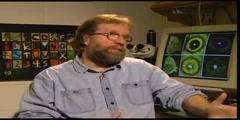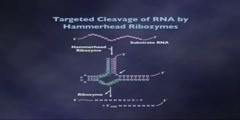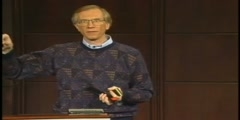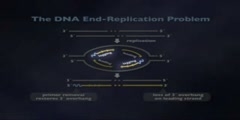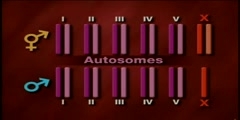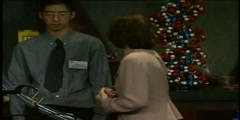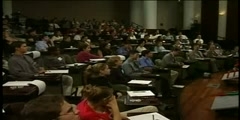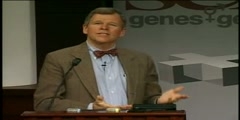Lecture on AIDS
This video presents a MIT lecture on introduction of Biology. The lecture was presented by Professor Robert A. Weinberg. In his lecture, Professor Weinberg describes the role of B cells, and T cells in immune system as well as how AIDS occurs. Edited by Ashraf /nProf. Robert A. Weinberg/nTranscript - Lecture 24/nIt comes acquainted with different antigens./nAnd recall that what we were talking about was the following, that there were several kinds of phagocytic cells. Phagocytic cells are cells that chew up other things, both macrophages and even more frequently, dendritic cells, many of which hang around lymph nodes by the way./nThey process antigens into oligopeptides. The oligopeptides get presented on the surface of these cells. Let's say, here's a macrophage, in the form of... through the class II MHC molecules which are displayed on the surfaces of the cells./nAnd, here's a typical oligopeptide that has been chewed up from one of the antigens that was previously internalized, eaten up by the macrophage, a dendritic cell, and then presented on the surface. Recall, then, we have an itinerant macrophage or dendritic cell. Could we turn up the sound just a little, just a notch? Thank you. And this dendritic cell or macrophage, I'll just call it a macrophage for the moment, is then moving largely through the lymph nodes, but wherever it moves, it's carrying along this oligopeptide./nAnd recall that we liken this voyage of it to a Middle Eastern market where there's a lot of bazaar stalls on either side of the road, and where instead of the usual male merchants, there's a lot of female merchants hanging out. And these females are called T helper cells./nThey're a kind of T lymphocyte or T cell. TH refers to their function. And here, all of these T helper cells, I'll indicate each of them here as a pink circle. And these T helper cells display on their surface to blow them up to a large size a T cell receptor that is organized much the way immunoglobulin molecule and antibody molecule's organized. That is to say, it has variable and constant regions./nIt's generated through the rearrangement of antibody-like genes. But it only functions, this T cell receptor or as it's called in the trade the TCR, only functions to sense the presence of antigens in the extracellular space. In fact, it senses antigens in the context of the MHC class II./nSo here's an MHC class II molecule. We can think of the MHC class II as being a hand, which is presenting this oligopeptide. I haven't drawn a hand, but you can pretend it's a hand. And this MHC class II is being presented by either a macrophage or a dendritic cell. And recall, we talked about the voyage of this macrophage or dendritic cell through this street here, and all these T helper cells are kind of lazily waiting along on the sidelines looking at what this phagocytic cell is hocking./nMost of the T helper cells are totally uninterested in what he's hocking. But one of them is struck. It's love at first sight, this one over here, let's say, because her T cell receptor precisely recognizes this oligopeptide in the context of the MHC class II molecule./nAnd, obviously I would like to draw thousands of these T helper cells here, each of which bears a different T cell receptor on her surface. I'm only showing one. And recall that after they make this encounter, the T helper cell gets all excited because she says, oh, I can't believe it, you have exactly the oligopeptide that's recognized by my receptor. And so, she gets all excited, and what she does is she proliferates because that's about all that excited cells can do./nWell, they can do other things, but again, we don't want to talk about it. Anyhow, so this particular T helper cell undergoes a clonal expansion, and is now activated, i.e. activated not only psychologically but physiologically by having encountered the antigen-presenting cell. The MHC class II, the macrophage is called an antigen-presenting cell./nIt's using its MHC class II molecules to do so. Macrophages and dendritic cells are pretty much similar in this respect. Macrophages go all over the body in the tissues. Dendritic cells tend to inhabit the lymph nodes. But from the point of view of our discussion today, we can imagine that they're functionally essentially equivalent. And having said that, now these T helper cells go looking for a congenial B cell./nSo, now we have a third actor in the drama, and the congenial B cell looks like this. And, the B cell has the following thing. The B cell has also on its surface, MHC class II molecules, which can be used in antigen presentation. But the B cell has an addition as we said last time, already, on its surface, IgM molecules./nAn IgM is a brand of antibody. Keep in mind that really one of the paradoxes that we haven't really fully settled on is the following question or the following issue. How is it that when a B cell sees a cognate antigen, why does it get stimulated? In other words, what is it that induces the B cell to start proliferating?/nHere's another version of what I showed you last time, where a B cell which makes the right antibody gets stimulated, but a B cell that doesn't does not get stimulated. And that's the issue we're wrestling with right now. So here on the surface of this B cell is an IgM molecule. Keep in mind an IgM molecule is an antibody molecule. Immunoglobulin means Ig. It's the earliest form of antibody that's made. Once again, it is antigen specific./nIts variable region has been rearranged through the fusion of different VDJ segments and somatic hypermutation. And, this B cell has a very interesting property. This is a naïve cell, and what this B cell does is as follows. It moves around the body, and if this B cell happens to find an antigen, which is recognized by its antibody, the IgM antibody./nThen the B cell will bind this antigen using its IgM molecule to do so. More importantly, it will then internalize this antigen and chew it up into little pieces, and then present it on its surface via the MHC class II molecule. So, let's just review what we've been saying./nBefore, we were talking about macrophages and dendritic cells, which gobbled up whatever they could, processed whatever they gobbled up, and put it on the surface again as MHC class II, and therefore the macrophages and the dendritic cells are really like sewer rats. They’ll just chew on anything and they'll put it on their surface. They're totally promiscuous in what they present on their surface. But here, the B cell is doing something rather similar. But the B cell isn't presenting whatever it happens to stumble across on its surface./nThe B cell is extraordinarily selective at what it presents on its surface. It only presents on its surface those antigens which are recognized by its IgM molecule. So here, it uses its IgM molecule to grab hold of this antigen. It internalizes the antigen, and then presents it back on the surface as an MHC class II molecule. So, there's a profound contrast in the behavior of these two kinds of antigen-presenting cells./nThe macrophages and dendritic cells, they just gobble up everything, and whatever they find, they put on their surface. They don't care with MHC class II. The B cell is extraordinarily selective and specific. It will pull in not through regular phagocytosis. It will pull in using its IgM receptor, specific antigens that are recognized by its IgM molecule, and then externalize it using its MHC class II molecule to do so./nLet's go back to the drama of the activated T helper cell, and here's the activated T helper cell. We'll draw her in pink. The T helper cell has just had an encounter with a macrophage, or dendritic cell. And, she's just left this marketplace. And now, she's very excited. So here is her T cell receptor. And she's very excited. She's putting out all kinds of growth factors and multiplying all over the place./nAnd she starts looking again now for a B cell with which she can react. Now, most of the B cells in the body will not have an epitope that she recognizes. Most of the B cells in the body will have picked up other kinds of things that happen to recognize by their T cell receptor, and will present it on the surface. A rare B cell will happen to internalize an antigen, and put on the surface, which is the same antigen that was recognized previously in the previous encounter./nAnd so, now this T helper cell goes around looking for an attractive male. What's an attractive male for her? An attractive male for her is one whose MHC class II molecule is recognized directly in the context, and this oligopeptide is recognized by her T cell receptor. And so, she'll come over here and she'll say excitedly to the B cell, you can't believe what just happened./nShe will say, I was just there. I just went through the market. I was sitting there in the marketplace, and along came a macrophage, and presented me with an oligopeptide that exactly fit in my T cell receptor. And now, she says excitedly, here I find a B cell has exactly the same oligopeptide presenting it to me. Isn't that a coincidence? And the B cell says, come on lady, get to the point. And she says, I just had an encounter with a macrophage dendritic cell./nI recognized the same oligopeptide in the macrophage dendritic cell that you have. And, the B cell says, well, I guess this must be some kind of meaningful encounter, and so these two cells get together. And what happens now is that the T cell, having recognized the oligopeptide, presented on the surface of the B cell now begins to send out signals to stimulate the B cell to proliferate./nAnd this B cell now begins to proliferate. And this B cell now begins to proliferate, as is indicated on this overhead, and eventually it starts making IgM molecules. It makes more of them, and then through the class switching that we talked about last time, it'll make eventually IgG secreted antibody gamma globulin molecules. So you see here the three essential cell types that participate in this. And why is it so complicated? Because it's extraordinarily important that the immune system doesn't inadvertently make antibodies that are inappropriate to express, because as we said before, if a certain of those antibodies and indeed possibly many of them could be autoreactive./nAnd what do I mean by autoreactive? I mean reactive with self. They could be antibodies that react with one's own tissues. And in so doing, they could create series kinds of autoimmune diseases. So, we have this sequence of failsafe reactions./nSo, when finally the decision for the B cell to get activated depends on a previous encounter with the same oligopeptide by a macrophage or dendritic cell, the T helper cell acting as an intermediary and now activating the B cell, once the T cell tells the B cell that the T cell has had a previous encounter with exactly the same oligopeptide, on that occasion being presented by a macrophage or dendritic cell./nAnd that is actually the mechanism by which we get this clonal expansion of B cells in the immune system, and ultimately how we get the productive antibody molecules. I mean, this is the image I showed you earlier, but I never really explained to you what the biology behind that is. I just said that antigen encounter on the part of the B cell causes that B cell to enjoy clonal expansion. And now, we've gone through the detail of deciding how three different cell types interact,/ncollaborate with one another to create the antibody response because this B cell then goes on to produce IgM as it already is doing, and then eventually IgG, and possibly a series of other immunoglobulins, IgE and IgA which have other purposes. Now, all of this actually is an important prelude to our main topic of discussion today, which is the disease of AIDS./nAnd, let me just add one other detail to this because the ability of a T helper cell to recognize MHC class II molecules depends on another cell surface molecule expressed by the T helper cell. And this other T cell surface molecule is called CD4. CD4, we don’t have to worry of what it stands for. CD4 is not an antigen specific receptor. CD4, instead, only recognizes MHC class II molecules no matter what they're carrying./nSo, there are MHC class II molecules which I've implied to you can carry thousands of different oligopeptides. CD4 doesn't care what's being carried by the MHC class II. It just binds to MHC class II molecules, thereby telling the T helper cell that an encounter has been made with an antigen-presenting cell./nSo, the ligand for CD4 is part of the MHC class II molecule. Now, that all leaves us in a very nice segue to the whole disease of AIDS. Let's just remember how the disease of AIDS was discovered. In 1981, there were a group of five young men who were all subsequently determined to be gay, be homosexual, who were discovered in San Francisco to have a very unusual kind of immunodeficiency./nThey all had night sweats. They got different kinds of otherwise unusual diseases. For example one of the things they got was a disease called Kaposi's sarcoma, which was otherwise known only in old southern Italian and Jewish men, Kaposi's sarcoma. But these were young men, and they were neither southern Italian nor Jewish./nThey got pneumocystis carinii, which is a microbial infection of the lung. And, in fact, they got all kinds of herpes virus infections. And they were all seen in a cluster by an alert physician who saw something very unusual, and therefore said, perhaps correctly, that they had acquired immunodeficiency./nNow, this acquired immunodeficiency is a syndrome. A syndrome, by the way, for your information, is a whole collection of symptoms that appear together. That's what a syndrome means. So, this term AIDS came from the fact that they had a whole series of symptoms. And, this was an acquired immunodeficiency rather than a congenital immunodeficiency rather than a congenital immunodeficiency because given the complexity of the immune system, you can imagine correctly that there are a lot of people in the world who were born with congenitally defective immune systems that are immunodeficient from birth because there's so many different proteins involved in regulating all of these different immune responses. But this was really different. It was an acquired immunodeficiency. It was seen in a very special subgroup, and so the race was on over the next two years to figure out what was going on./nNow, by coincidence, starting in 1970-'71, retrovirus research had begun. And as it turned out, retrovirus search, President Nixon's war on cancer, retrovirus research was motivated largely by the notion that human cancers are caused by retrovirus infections. And, that led to the war on cancer. And the notion behind the war on cancer was totally wrong because it turns out that only a minute fraction of human cancers have anything to do with retrovirus infections, although as we've said earlier, retroviruses proved to be very important tools experimentally for discovering proto-oncogenes and oncogenes in the genome./nBut if you ask, what fraction of human cancers are actually due to a human being infected by a retrovirus? It's almost zero. It's a small fraction of a percent. Nonetheless, in the 1970s, there was an enormous effort made in trying to figure out all of the biology of retroviruses./nAnd by the late 1970s, people concluded this was very interesting science. Indeed, proto-oncogenes and oncogenes were discovered, but that it was pretty irrelevant to understanding directly how human cancer arose, which human cancers could be explained rather by somatic mutations in the genome. In 1981, the AIDS infection arose./nAnd, what happened subsequently is that there was a race on to try to find out what the infectious agent was because it seemed to be an infectious agent. It was being spread from one gay young man to another that was used to induce this. And within two years, by 1983, the culprit retrovirus had been found. I'm telling you this long song and dance to give you the following insight./nIf there had not been a decade of earlier retrovirus research, it could have taken the scientific community many, many years to figure out what was causing AIDS. But through happenstance, through a sheer stroke of luck, by the time the first individuals suffering from AIDS were encountered in '81, there was already a backlog of a decade's worth of detailed retrovirus research, which made it possible to discover, to discern almost within months what was causing it. And, the agent that was causing it was a retrovirus./nThe retrovirus here has indicated, very schematically, these artists' drawings never have any resemblance of what things really look like. And if they do, it's only by coincidence. Let me borrow your laser pointer here for a second. So here, and this is what a retrovirus looks like just to give you a feeling. In the center, there are two single stranded RNA molecules. The virus is diploid. There's two copies of the genome for reasons we still don't understand./nSurrounding it is a so-called nucleocapsid, which is responsible for protecting the RNA molecules. These two pink dots are reverse-transcriptase molecules because as you'll recall, when retroviruses infect a cell, they carry the enzyme with them into the cell. You could say, why don't they make it after they get into the cell? And it's not totally obvious why, but this is what they do. There's another shell of proteins out here. And then, beyond that is a lipid bilayer. And this lipid bilayer is, as you may recall,/nstolen from cell from which the virus is protruding because if you look at retrovirus-infected cells, here's the plasma membrane of a retrovirus-infected cell. Here you can see a nucleo-capsid forming with the RNA molecules. And this shoves its way, protrudes its way through the plasma membrane, stealing a patch of plasma membrane from the infected cell, and at the same time this part of the plasma membrane carries with it viral glycoproteins./nAnd viral glycoproteins, they're obviously glycosylated, as are many other extracellular proteins. And in this case, they're indicated with these yellow ovals, and these viral glycoproteins are used to attach to subsequently infected cells so what happens is that when the retrovirus gets out of the cell, I'll draw it again schematically here, it has this glycoproteins coat on it with the plasma membrane, and it uses these glycoproteins spikes./nI just won't put the yellow ovals on them, to attach to cells which need to be infected. So, here's a target cell that needs to be infected. So, the target cell, and how does this virus know how to attach to this cell and not to other cells? Because on the surface of the target cell are certain cellular proteins, which are used for normal cell physiology, which are there, and which the virus has opportunistically developed an affinity for./nSo here on the surface of a target cell might be a normal cellular protein to which the viral glycoprotein combined. Or, if you want to get technical, this enables the virus particle to adsorb, to attach to. Notice the D here rather than the B, to adsorb to the surface of the target cell. Importantly, what's the cell surface protein of the target cell to which HIV virus adsorbs? It's our old friend CD4./nI.e. the HIV particle likes to adsorb, preferentially adsorbs to the surface of cells that express the CD4 molecule on the surface. Note, by the way, that just five minutes ago, we described a totally different function of CD4. CD4 over here was said to represent the means by which the T helper cell can recognize MHC molecules being displayed on the surface of either of these dendritic cells or B cells./nBut here we see CD4 in a totally different context. Here, the CD4 represents the docking site to which the viral glycoprotein can attach, enabling the virus, which came to be called human immunodeficiency virus./nIn fact, the virus was discovered by two groups simultaneously, one of them called HDLV-3, the other called lymphadenopathy virus. The first group was American. The second group was French, and they allowed Herald Varmus, one of the co-discoverers of the proto-oncogene to act as sort of the judge to see what it would be called because there was great political tension. Would it get the American or the French name depending on which of the two warring scientists, and they were warring, could claim discovery?/nSo, he had a Solomonic decision. He decided to name it human immunodeficiency virus. That was a compromise. And by the way, some people in less than charitable mood say, well, of course he named it human immunodeficiency virus because those are almost his own initials. But, I think that's unfair. These were his initials./nHere's human immunodeficiency virus. He named it for a perfectly good reason. Anyhow, that broke the Franco-American diplomatic tension, and now one began to realize that HIV or human immunodeficiency virus attacked T helper cells and preferentially infected T helper cells by virtue of the ability of the virus particle to dock itself to the CD4 molecules presented on the surface of these cells. By the way, what happens afterwards, after the virus becomes adsorbed to the surface of an infectable cell such as a T helper cell./nSo, here's the virus particle. Here's the surface of a T helper cell. What happens then is these two lipid bilayers fuse with one another so that now they became one, and now the internal contents, the nucleocapsid which contains the RNA and the reverse transcriptase now has direct topological access into the cytoplasm of the cell./nIn fact, the glycoprotein, the yellow ovals there of human immunodeficiency virus actually had two functions. First, it specifically recognizes the CD4 molecules to which it then anchors or adsorbs the virus particle. And secondly, it also has fusing functions, i.e. it's capable of causing the lipid bilayer of the virion, or the virus particle, to fuse with that of the plasma membrane of the infected target cell./nAnd, once it's in there, then the virus can begin to do its replication. Now, the replication of the HIV virus was already pretty well understood by the time that HIV was discovered in 1982-'83 because of this backlog of retrovirus research. And just to review for you how retroviruses replicate, RNA is put into the cell, single stranded RNA./nIt's called plus strand RNA because it is of the same polarity of the same strandedness as messenger RNA. If it were complementary to messenger RNA, then it would be called minus strand RNA. This is reverse transcribed by the reverse transcriptase, which is carried into the cell. RT stands for reverse transcriptase. And now, one gets a double stranded DNA molecule, a copy of the virus./nAnd this DNA copy is sometimes called a provirus. And just to review, this provirus is then subsequently integrated into the chromosomal DNA of the cell. So, here's the provirus. Here's the chromosomal DNA. And then, this integrated provirus then serves as a template for making progeny plus-stranded RNA./nAnd this progeny plus-stranded RNA, which is, by the way, forward transcribed by RNA polymerase II, which does the bulk of the heavy lifting in terms of making RNA in the nucleus, this plus-stranded RNA can have two functions recall. One, it can serve as a template on ribosomes for making viral proteins such as the viral capsid proteins. And two, the plus stranded RNA can in turn be encapsidated, i.e. it can become packaged./nEncapsidate equals, it can become packaged by the viral proteins to make progeny virus particles, which can then bud, as I've indicated here, from the surface of the infected cell. And in fact, we can imagine three classes of viral proteins that are required for replication. First is the reverse transcriptase, which is encoded by the viral RNA. Second are the capsid proteins which carry the RNA, and third are the viral glycoproteins up here which these glycoprotein spikes which are trans-membrane proteins that protrude from the virion, and allow the virion to adsorb to the surface of infected cells./nIt turns out that this virus has become an extremely difficult virus to deal with. For most viruses that we have encountered over the last 100 years, one has had great success in making vaccines against these viruses including, as we discussed in great detail, polio virus./nIn fact, for smallpox, another virus, the vaccine effort was so successful that about 20 years ago, the last case of smallpox finally occurred in Eritrea in northeast African when some herdsmen had the last documented case. And since that time, there have been no documented cases of smallpox in the wild, and there's only two or three stocks of smallpox virus surviving./nOne of them is in some type of research center is Moscow, and the other is probably in the Communicable Disease Center in Atlanta, Georgia. And, there's been great debate, by the way. Should one get rid of those surviving stocks, or should one keep them for research? By now, you guys aren't vaccinated against smallpox because nobody gets it anymore, and there's a certain risk of getting a small pox vaccine./nI am, so I'm not worried, but maybe you should be because starting about 20-25 years ago, one stopped vaccinating people against smallpox because it just doesn't seem to be necessary. Why give them the risk of having some disease which happens in one out of a million vaccinees (sic) instead of just leaving them unvaccinated? Well, I digress. Back to HIV, the fact is we've had enormous lack of success in making a good kind of vaccine against HIV, and why is that?/nWell, one of the critical things is that HIV is attacking and replicating in the T helper cells, and the T helper cells it turns out are the lynch pins of the immune response. Keep in mind that the T helper cells that I've shown you in this diagram over here represent these critical cellular messengers between the dendritic cells and the macrophages on the one hand, and the B cells on the other. You wipe them out, and the ability to make new antibodies is totally compromised./nIt turns out the T helper cells can also help to make another class of cells which are called cytotoxic T cells, another kind of T cell, cytotoxic, and these cytotoxic T cells have on their surfaces T cell receptors, which they can use to recognize infected cells, and kill infected cells./nSo, the cytotoxic T cells aren't involved in making antibody responses at all. The cytotoxic T cells are involved in recognizing cells that are expressing unusual or foreign antigens on their surface, and killing those cells. That's the function of the cytotoxic T cells. Obviously, it's quite different from the helper T cells. But once again, the activation of the cytotoxic T cells, and empowering them to make these attacks on abnormal cells depends on the helper T cells./nOnce again, the helper T cells represent the lynch pins, the keystones, of the immune response. But, because of this tropism, and when I use the word tropism, I mean because of the desire of the virus to phase towards and infect a certain subset of cells in the body, this tropism of HIV for infecting and killing helper T cells, the production of antibodies is strongly compromised on the one hand, and the production of cytotoxic T cells is compromised on the other./nThere's another aspect of HIV infection which is also very insidious, and that's the following. It turns out that the body can initially make an immune response against an infecting HIV particle. And here's kind of what things look like. I hope this shows up here. Who could lend me a laser pointer again?/nExcellent, thank you. OK, so here's what happens. And, there's two graphs here. On one hand are the cytotoxic T cells, and their level is shown on the solid line here. So, look at the course of infection. It's plotted here in weeks and years. If you see what happens in a primary HIV infection, and here on the right on this ordinate here is the viral titer indicated on a log scale./nSo, this is a semi-log graph for the viral titer. And what you see over here is that when you initially infected it, there's an enormous burst of viral titer. It goes up by four or five orders of magnitude, and then it falls down dramatically by two or three orders of magnitude. And it goes on, and it remains depressed by two or three orders of magnitude below its initial height for a number of years./nWhat's going on then? The immune system has come to grips with the presence of the HIV virus, and begins successfully to try to eliminate it. How does the immune system eliminate HIV? By two mechanisms. First of all, the immune system makes neutralizing antibodies of the sort that float through the serum, and are able to glom onto the virus particle, attach to the virus particle, and thereby prevent it from being infectious./nAnd secondly, as I mentioned last time, the immune system also can recognize virus-infected cells and kill them. And by killing a virus-infected cell, the immune system prevents that cell from continuing to function as a factory for putting out new virus particles. So, there's two ways by which virus particles are eliminated, but note here that the virus infected cell which is critically important among all the cell types in the body are the T helper cells./nSo, certain components of the immune system are killing the T helper cells that are involved in harboring and producing HIV virus. So, there's an auto destruction on the part of the immune system. Look, at the same time, at the titer, at the number of CD4 cells, and they're indicated here on the left ordinate, in this case, cells per microliter. CD4 cells originally started up here./nThey go down by a factor of two or three for the first weeks, and then over a period of years there's this ongoing struggle between the HIV particle and the immune system as the number of CD4 cells, and the CD4 cells we've said before, the CD4 positive cells are these T helper cells as the number of these cells per microliter of blood progressively declines further and further and further. And finally, the number of CD4 positive cells, i.e. T helper cells, gets so low that the body is totally overwhelmed, and the patient then dies of an opportunistic infection./nWhat do I mean by an opportunistic infection? Well, what I mean is that we are surrounded all the time by all kinds of microbes, which given the chance will kill us within a couple days. Keep in mind, I told you that there are in your gut, as many bacterial cells as there are the rest of your body./nAnd some of these bacteria are really nasty. I remember, my grandfather got kicked in the belly by a horse, and three days later he was dead. Why? Because some of the bacteria got out of his gut, got into his peritoneal fluid cavity, and gone. This was the pre-antibiotic era, by the way, never new him very well because he died in 1916. I'm just telling you that your gut is full of all kinds of nasty things. On your skin, not just on my skin, but on your skin there are billions of staph aureus bacteria. They're just waiting to cause you problems./nDon't look. It's OK. Don't look too closely. They're just waiting to cause a nasty infection as well. Everyday we breathe in all kinds of awful microbes, fungi, and all these kinds of things including pneumocystis. And, rarely do we get sick because of the extraordinary competence of the immune system to respond to such a diversity of infectious agents, and to hold them at bay./nIn the 20th century, the percentage of people who die of infectious diseases has plummeted both because of the immune system and because we're eating healthier up to a point, and because of antibiotics and antifungals. But if the immune system is defective, all the antibiotics in the world, and all the antifungal agents can't save a patient if their CD4 cells get down very, very low because these antifungals always worked as collaborators with the immune system./nThey get rid of a bulk of the infection, but the immune system has to wipe out the residue. And what you see here is a struggle going on for a period of three, four, five, six years where the viral titer is successfully held low, and then all of a sudden as the immune system weakens the viral titer goes up to high levels, wipes out the residual T helper cells, and death invariably ensues./nNow, I've given you one reason why the immune system can't deal with this virus, because virtually all other viruses attack various tissues throughout our body, but they don't attack the immune system itself. Here, we're having a virus which is attacking the defense of the body, that is to say, the immune system. So, one reason is the continuing depletion of the T helper cells. They can regenerate themselves for a period of time, very impressively long period of time, four, five, six, seven years. But ultimately, they get worn out, they die./nAnother reason is this is antigenic variation. Now, if you look at the retrovirus particle, what you see is on the surface the glycoprotein. It's right here. And, the glycoprotein is used by antibodies to recognize and bind to the virus particle and neutralize it, same as with polio virus./nBut let's imagine, as happens to be the case, that the virus is highly error prone in replicating its genome. When I say error prone, I mean that instead of the host cell, polymerase, which makes ultimately one mistake out of a billion, the viral replication machinery makes mistakes all the time. It's quite defective in the fidelity and the faithfulness with which it replicates nucleic acid./nThat means that after each cycle of replication, there are in effect mutant viruses that have been produced, mutant progeny viruses, and where the mutation rate instead of being one in 10^9 might be one in 10^2 or one in 10^3. And that means that there are continually novel variants of HIV being produced in a person's body. Let's imagine that that person has developed antibodies against the viral glycoprotein of the virus that initially infected him or her./nLet's imagine that. And those antibodies are successful in eliminating most of the virus particles of the sort that initially infected that individual. But now we can imagine the possibility that in the imperative weeks or months, a new strain of HIV will arise within that individual's body a mutant strain in which the sequences that code the viral glycoprotein had been changed slightly. And now, the viral glycoprotein has changed slightly its epitopes./nAnd the initially developed neutralizing antibody that recognized the initial cohort of virus coming into the cell in the individual no longer works because the virus has undertaken a strategy of immune evasion, sometimes it's called immunoevasion, in which now the viral glycoprotein, although it's still competent to affect a replication cycle to adsorb and fuse to the surface of an affected cell./nMany of the epitopes, many of the oligopeptide antigens on the surface of the glycoprotein have been changed slightly through amino acid substitutions, through point mutations. And hence, the initially developed antibody, which previously was successful in glomming on and neutralizing this virus particle is rendered ineffective. And now, this second wave, this new strain of HIV will grow up and expand in that individual, and once again provoke a new immune response./nAnd, the same cycle will repeat it. The second strain will now soon be eliminated, but while the elimination is going on, there's strong Darwinian selective pressure favoring the outgrowth of yet another mutant strain which is not recognized by either of the two initial antibody responses. And so, over this period of many years, what's happening is that the virus in the immune system are playing continual cat and mouse games with one another./nThe immune system goes after the virus; the virus moves over here; the immune system goes after that; and so you have a succession of antigenic variance. Here's one variant. Here's another variant. Here's another variant, and so forth. By the time the immune system succeeds in getting rid of the first variant, a new variant has appeared, and then the immune system ramps up its defenses and tries to get rid of that. And, it succeeds almost./nBut by the time that has happened, yet a third variant has appeared. And so, there are these continual clonal successions. A clonal succession represents a time where one clonal virus explodes, expands. It's soon eliminated, collapses, and then another clone comes up and expands. And this goes on. This works OK for about four, five, six years. But ultimately, the ability of the T helper cells to replenish themselves and to continue to mount an effective immune response fails./nThere's yet another aspect of HIV infection which is so insidious, and that's the following. Let's look at the viral life cycle right here, and the provirus, remember the provirus is this thing right here, which is integrated into the chromosomal DNA. And, we can assume that this provirus is transcribed by RNA polymerase too, and I will tell you that the promoter of the provirus is carried in by the proviral DNA, and actually depends on transcription factors that are present in the T helper cell./nIn fact, you'll recall that the T helper cell gets excited sometimes, and other times it's not excited. And she gets excited if I can attach gender to a T helper cell, when she encounters macrophages and dendritic cells, and/or when she encounters B cells. Other times, the T helper cell is kind of quiet and unactivated. And, what happens when a T helper cell gets activated through these encounters?/nThe T helper cell starts making her own transcription factors, which are used in order to facilitate these complex biological interactions with both antigen-presenting cells, macrophages and dendritic cells, and later on, B cells. And those same transcription factors that the T helper cell uses to turn on its own expression program are used by the provirus to transcribe its own DNA,/ni.e. HIV has evolved a proviral promoter sequence here which takes advantage of transcription factors that are present uniquely in an activated T cell. And when those transcription factors are available, not only does the T cell become activated, but the provirus becomes transcribed because these transcription factors now enable RNA polymerase II of the host to transcribe the provirus. But let's imagine now, if we follow that scenario to its conclusion, what happens when the T cell is not activated?/nWhen the T cell is quiescent, when it's quiet, these transcription factors are unavailable to attach to the promoter of the integrated provirus, and as a consequence the provirus will not be transcribed. It won't make RNA, and in that situation, how will anybody know that there's an integrated provirus in there? Well, the provirus is not being transcribed. The transcripts aren't being used to make viral protein./nSo in effect, the only evidence for the existence of HIV in the cell is this segment of DNA. In other words, this provirus can hide out in an unactivated quiescent T cell indefinitely. And, the immune system can't know that there's a provirus hiding out in this T helper cell because it's not being transcribed. And therefore, one can have a quiescent T helper cell, and several other cell types in the body, macrophages also, which aren't transcribing their proviruses./nWell, you'll say, so what? It doesn't make any difference. If it's not being transcribed, it's not going to hurt the individual. But, keep in mind that the idea of getting rid of a viral infection is to eliminate all traces of a viral genome from an infected individual, and that's what happens with smallpox and with poliovirus, and with measles and virtually all the other infections we have. But here, we have a situation where the viral genome can hide out in a latent or inapparent (sic) configuration./nThere's no way to know it's there, and it may reemerge days, weeks, months, even years later because this previously transcriptionally silent provirus may suddenly be present in a cell which suddenly becomes activated. And now, an individual who "thought" quote unquote that he or she had gotten rid of HIV infection all of a sudden realizes there are viral genomes still hiding out in the body./nAnd what that means is that in effect, it's absolutely impossible to rid the body of HIV infection ever. Once an individual is infected, in fact, that individual is infected for life. There's no way on Earth what we have at present of getting rid of the viral infection because the viral genome is always hiding out here or there in different interstices of the immune system, hiding out in transcriptionally silent state./nOf course, we have very effective drugs against HIV now. Some drugs inhibit the reverse transcriptase. Others inhibit the processing of the capsid proteins, that is, the proteins which these capsid proteins happen to be cleaved from a large, high molecular-weight protein precursor into individual proteins, and there's an inhibitor of the protease that cleaves these proteins to the mature size. And, those drugs together hold the viral infection at bay for maybe 10, 15, 20 years./nBut keep in mind that even though the viral infection is being stopped by these drugs, first of all, the virus is always hiding out in the bodies of such individuals in this latent, hidden form, and secondly, there may be a slow depletion of their T helper cells in spite of the effectiveness of these drugs. On that cheerful note, I wish you a good day./nwww.mit.edu

